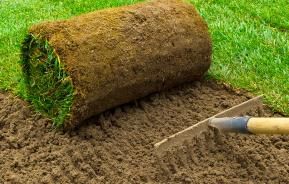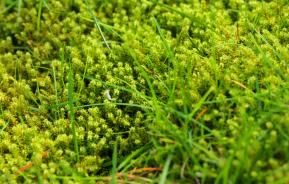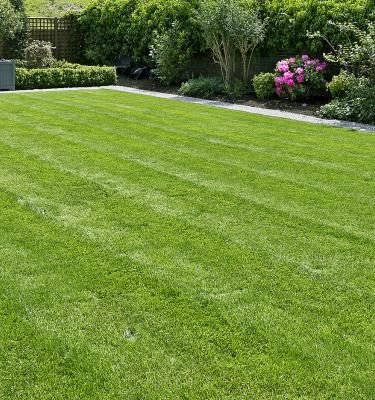
How to look after your lawn: 7 top lawn care tips
Here's our 7 tips for great lawn care
Lush, green, cool and like a carpet underfoot in summer, a healthy lawn makes a garden even more beautiful. If you’re wondering how to look after your lawn and keep it looking its best, follow our lawn care advice for a healthy lawn that you can enjoy all summer long.

1. Get rid of lawn weeds and moss
Weeds and moss can appear even in the best-kept lawns. As well as spoiling the look of your lawn, they compete with the grass for water and nutrients, so they need to be kept under control. Some of the most common lawn weeds, such as dandelions, docks and plantains, have long tap roots, and it’s important to get the whole root out to stop the weed from growing back.
If you’re dealing with a large lawn where weeds have taken over, you may need to apply a lawn weedkiller to get things back under control. Lawn weedkillers are specially designed to target lawn weeds without killing the grass as well. They’re most effective when applied as part of a spring lawn maintenance regime or as summer lawn care, when both the grass and the weeds are growing strongly. Always follow the manufacturer’s instructions when applying lawn weedkiller – this will give you the best results as well as keeping you safe!
Getting rid of moss in lawns
Moss tends to grow in damp, shady areas, especially in compacted or poorly drained soil where grass struggles to take hold. Small areas of moss can simply be raked out, using a spring-tine rake or, if there’s too much moss in your lawn to tackle by hand, apply a moss killer.
These easy lawn care tips can reduce the build-up of moss in your lawn:
- Aerate the soil as part of your autumn or spring lawn care routine – this reduces compaction and improves drainage.
- Try to ensure your lawn receives as much sunlight as possible.
- Sow shade-tolerant lawn seed in shady areas.
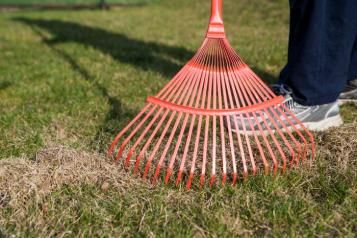
2. Scarify your lawn
As they grow, lawns build up thatch – a layer of dead plant material that accumulates around the roots of the grass. Thatch stops water and fertilisers from reaching the soil and feeding the grass, so removing it is an important part of your lawn maintenance routine.
Thatch can be removed by scarifying the lawn – in other words, by raking out the dead plant material. You can do this manually if your lawn is small, by raking firmly over it using a spring-tine rake. As well as removing thatch, scarifying lawns also weakens weeks by damaging their leaves. However, it can be quite hard work, so for larger lawns it’s best to use a mechanical scarifier.
Scarifying the lawn is usually done as part of autumn lawn care, but it can also be done in spring.
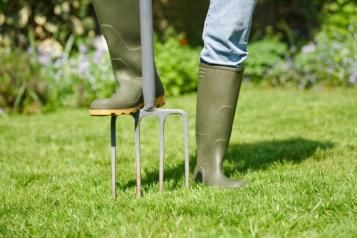
3. Aerate your lawn
Walking, running, playing games – all those things we love to do on our lawn gradually compact the soil, squashing out the air so that the soil no longer drains well, and nutrients can’t reach the grass roots. One of the best lawn care tricks for keeping your lawn healthy is to aerate the soil annually. This usually forms part of autumn lawn care, but you can also include it in your spring lawn care routine if you’re too busy in autumn!
On small lawns, the easiest way to aerate your soil is with a garden fork. Insert the tines of the fork into the soil about 10-15cm (4-5in) deep, then gently lean on the handle of the fork until you see the ground around it lift very slightly. This helps break up any compaction in the soil, while the holes made by the tines of the fork allow air and water to get further into the soil where the grass roots need them.
Move the fork to an adjacent area and repeat the process until you have covered the whole lawn. For large lawns, it’s easiest to use a mechanical aerator.

4. Overseed your lawn
Overseeding is an easy lawn care tip that helps to keep your lawn looking lush. Sowing lawn seed is also a good way to fill in those small bare patches that can develop in the lawn over time. Overseeding a lawn is best done in spring or autumn, when there’s usually enough rain to help the newly germinated grass seedlings establish. A useful tip when sowing grass seed is to wait until the temperature is reliably over 10°C, as the seed won’t germinate in cold soil.
How to overseed a lawn
1. Remove any weeds, then mow your lawn on a low setting and scarify it to remove any thatch.
2. Aerate the lawn to break up any compacted soil.
3. Spread a lawn dressing over the lawn, using the back of a flat-headed rake to spread it evenly across the area. This easy lawn care tip has two benefits – it fills in any small dips in the lawn, and also works the lawn dressing into the holes created by aerating, thus improving soil drainage.
4. Sow the seed by using a lawn spreader, spreading it in two passes at right angles to each other to ensure even coverage. A lawn spreader is effective for making sure you sow grass seeds evenly.
5. Once the seed has been sown, rake over it to ensure the seed is in good contact with the soil, then water the area lightly.
6. Water twice weekly until the grass is well established.
7. Wait until the grass is around 5-8cm tall before mowing it for the first time.
How to repair bare patches in your lawn
With all the hard use our lawns get during the year, it’s not surprising that bare patches occasionally appear. Applying a lawn patch repair mix is a simple, cost-effective solution, and when correctly applied, it can start to fill in the gaps with fresh new shoots within just a couple of weeks. Here’s how it’s done:
1. Prepare the ground a few days ahead of time by removing any weeds. Rake it over to break up the soil surface.
2. Spread the patch repair mix over the bare area, either by hand or with a lawn seed spreader, spreading it evenly.
3. Water thoroughly.
4. If necessary, cover the area with netting to stop birds from eating the grass seeds.
5. Water regularly until the grass is well established.
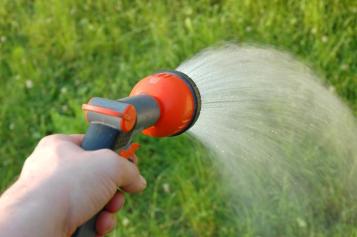
5. Water your lawn
If you’ve sown grass seed or laid turf for a new lawn, water it regularly until it becomes established. You’ll usually need to water new lawns daily for 4-6 weeks. However, the good news is that once your lawn is well-established, it shouldn’t need any regular watering. Your lawn may turn brown in hot, dry weather, but resist the temptation to water it too soon. Grass is amazingly resilient and will spring back into life as soon as the rain returns.

6. Mow and edge your lawn
Regular mowing is one of the easiest lawn care tricks to keep your lawn looking its best and is a key part of summer lawn care. As well as keeping the grass to a tidy length, regular mowing also cuts down weeds like dandelions and plantains, deadheading them before they can set seed and spread. Follow these simple lawn mowing tips for a thick, healthy lawn.
Lawn mowing tips and tricks
• When mowing your lawn, never cut off more than one-third of the length of the grass. This leaves the grass with enough foliage to make food and grow strong. When you first start mowing in spring, use a high blade setting on your mower, and gradually lower this in summer once the grass is growing fast.
• To keep your lawn short and neat, mow at least once a week in summer.
• In hot, dry summers, mow your lawn less often and on a higher blade setting. Leaving the grass longer keeps the roots shaded in hot weather and helps retain moisture in the soil.
Edging your lawn
Well-trimmed lawn edges give your garden a well-cared-for look. Keep them looking neat by trimming them regularly with edging shears. If the boundary between borders and lawn has become a little blurred, cut new edges with a half-moon spade – this handy tool has a sharp curved blade for cutting down into old turf to create a new edge, and can also be used as a spade to lift out the cut turf and make a channel around the edge of the border.







